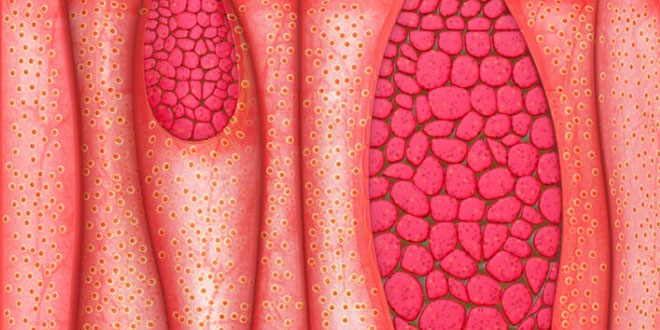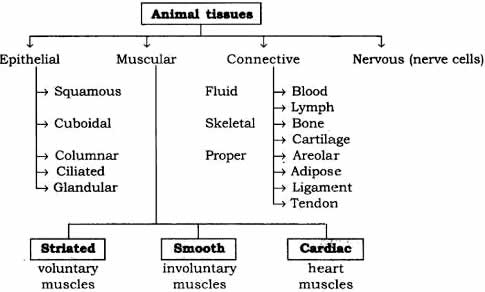Question: Show the types of animal tissues using flow chart.
Answer:
Question: What is connective tissue? Explain its types.
Answer: The connective tissue consists of different types of cells, all of them perform same function.
- Areolar connective tissue: It is found between the skin and muscles, around blood vessels and nerves and in the bone marrow.
Areolar tissue fills the space inside the organs. It supports internal organs and helps in repair of tissues. - Adipose tissue: Adipose tissue stores fat, found below the skin and between internal organs. The cells of this tissue are filled with fat globules. It acts as insulator due to fat storage.
- Blood: It has a fluid called plasma, in plasma are present red blood cells, white blood cells and platelets. Blood flows all over the body and helps in the transport of gases, digested food, hormones and waste material to different parts of the body.
- Lymph: Lymph carries digested fat and lot of white blood cells in the plasma. Bone: It forms the framework that supports the body. It supports the different parts of our body. It is strong and non-flexible tissue.
- Cartilage: It is present in nose, ear, trachea and larynx. It smoothens bone surfaces at joints.
- Tendon: It connects bone and muscles. These tissues are fibrous, flexible and with lot of strength.
- Ligament: It connects bone to ‘bone. It is elastic, has lot of strength.
Question:Describe ‘epidermis’ in plants.
Answer: Epidermis forms the entire outermost layer of the plant. It is made up of single cell layer. It protects all the internal parts of the plant.
On aerial parts, epidermis secretes waxy, water-resistant layer on their outer surface. This helps in protection against loss of water, mechanical injury and invasion of parasitic fungi.
In leaves, epidermis consists of small pores called stomata. These pores helps in the transpiration and exchange of gases, like oxygen and carbon dioxide for plants.
In roots, epidermis have long hair-like parts that provide greater surface for water absorption.
In desert plants, epidermis has a thick waxy coating of cutin which acts as a water proofing agent.
Question: Explain the “complex tissue” of plants.
Answer: Complex tissues are made up of more than one type of cells. All these cells co-ordinate to perform common function. These are—xylem and phloem. Both are conducting tissues and form a vascular bundle.
- Xylem consists of—tracheids, vessels, xylem parenchyma and xylem fibres. Most of these cells are dead. Tracheids and vessels helps in water transportation, parenchyma stores food and helps in the sideways conduction of water and fibres are mainly supportive in function.
- Phloem is made up of four types of elements—sieve tubes, companion cells, phloem fibers and phloem parenchyma. It helps in the transportation of food in both the directions, i.e. from leaves to roots and to other parts of the plant.
 Class Notes NCERT Solutions for CBSE Students
Class Notes NCERT Solutions for CBSE Students







